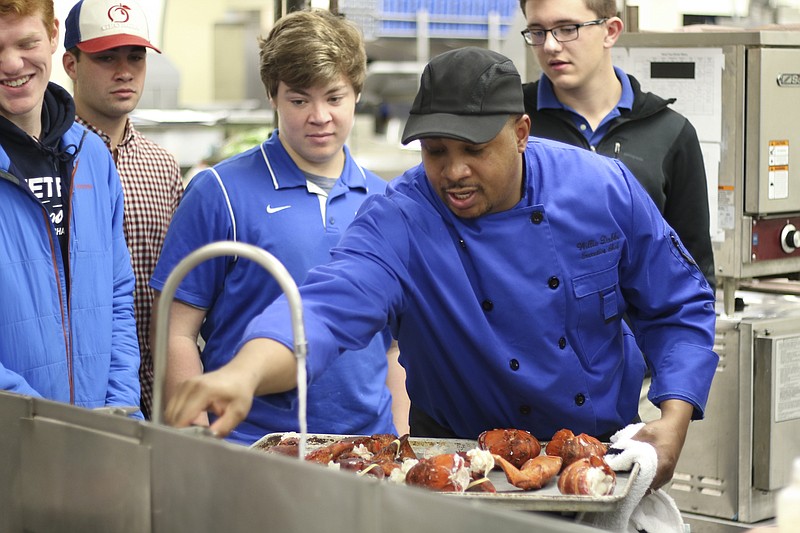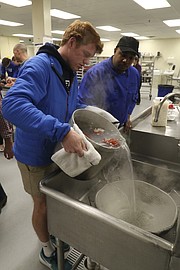Andrew Cook knows his way around the kitchen; he's been cooking since he was a kid. The McCallie School junior says he likes the challenge of looking up new recipes, then testing his skills on them.
"I don't like to make the same thing twice," says Cook.
McCallie senior Hudson Owens admits he has "no clue how to do anything in the kitchen. But I need to know because next year I'll be in college, starting a new chapter of my life. I'll need to be independent and know how to cook for myself."
Both guys learned some new skills last week during McCallie Master Chef, one of 40 hands-on learning classes outside the traditional classroom setting. For two weeks, academic classes in the Upper School were suspended so students could participate in a Tornado Term program.
Tornado Term, or T-Term, was launched this semester after two years of research as to what students needed to move forward in life, says Chris Carpenter, McCallie's director of student academic affairs.
"We know boys are hands-on learners," Carpenter says. "We also know that the skills we see in Tornado Term - collaboration, design-thinking, experiential - are the skills that these guys need to be successful in the 21st century. T-Term allowed us time to step away from our traditional curriculum and engage in this type of learning."
Forty topics of interest were chosen by teachers. Carpenter says they ranged from "The History of Hip-Hop" to "The Ethics of Sports" and "Physics of Radio." Others included yoga, specific sports, filmmaking, a food class chronicling the immigrant experience in America and foods they introduced, and one on the History of Southern Rock that included a road trip to the legendary recording studios in Muscle Shoals, Ala.
Each class was led by two McCallie teachers. Chris Cushenbery, math teacher and head soccer coach, and Joel Coffman, director of McCallie's counseling center, led 17 teens in McCallie MasterChef.
"The point of this class was to expose students to the kitchen, help them learn their way around so they'd get more comfortable preparing food for themselves. Some of them have done things in a kitchen before; some have only microwaved," says Coffman.
He says the teens learned knife skills during a visit to Southside's Sweet and Savory Classroom and prepared a meal with Alleia's Daniel Lindley.
"We spent a day with Daniel Lindley and cooked his favorite pasta dish with him. I was ecstatic the whole day," says Cook. "I worked with the best chef in the city, learning from him!"
One day was spent in a grilling/smoking lesson and they smoked meat overnight before taking it out the next day for a meal. Much like Chef Gordon Ramsey leads television's "MasterChef," a McCallie class involved a pro showing how to prepare a food, then the guys trying to replicate the lesson. McCallie alumni Hardin Cowan and Nick Kyriakidis were among chefs leading hands-on lessons.
"We learned how to cook eggs," says Cowan, executive chef at Terra Mae, of his morning visit to McCallie's kitchen. "At McCallie School, you don't get any home ec. The point was to teach them how to feed themselves once they are away from home.
"We started off with sunny-side up, then over-easy eggs. They learned how to poach an egg, then learned the one-pan special: omelets with hash browns, peppers, onion and bacon. The thing we worked on most was the omelet.
"They were a smart group of guys who caught on quickly. As the day progressed they peppered me with questions," says the chef, who graduated from McCallie in 1996.
A field trip to Acropolis Restaurant, owned by Kyriakidis, class of '91, taught how the back of the house operates.
"I showed them how we organize cook lines and stations," Kyriakidis says. "They looked at organization, terminology and we moved them through the prep line. We talked about purveyors we work with at the restaurant and they watched us fabricate, or break down, a whole salmon. We wanted them to see the salmon coming in off the truck, then the steps taken before it's served in the dining room."
He says the hands-on element followed a demonstration on how the restaurant builds its cakes and pastries. The guys made their own eclairs and dipped strawberries.
"There was a time when kids grew up in the kitchen with their grandmother or someone who cooked," says Kyriakidis. "We're getting away from that, so this was an introduction to see what it takes to get something on the plate."
McCallie School's new Executive Chef Willie Dabbs taught the teens how to make Lobster Creamy Herbed Pasta. He involved them in every step, from chopping veggies to making pasta and cutting it into fettuccine noodles.
"I didn't have anyone to mentor me," says Dabbs. "When I was coming up we didn't have opportunities for things like this. That's why I freed my whole day up for them."
Aaron Corcoran says T-Term renewed his interest in cooking.
"I use to cook a lot when I was younger until middle school. I liked to bake," says the McCallie junior. "I've always loved cooking and I love eating. I'm leaving for college in a couple of years and I'll need to know how to cook for myself because I can't eat fast food every day."
Contact Susan Pierce at spierce@timesfreepress.com or 423-757-6284.
Recipes
Lobster Creamy Herbed Pasta 2 live lobsters, each about 2 3/4 pounds 3 tablespoons olive oil 4 pounds onion, roughly chopped 4 pounds carrots, roughly chopped 4 pounds celery, roughly chopped 1/4 cup chopped spinach 2 large grape tomatoes, cut in half 1/3 cup lobster stock 2 tablespoons white wine vinegar 2 fresh Italian parsley sprigs 2 cups whipping cream 1.5 pounds fettuccine pasta, recipe follows Bring very large pot of salted water to boil. Add lobsters. Boil until cooked through, about 12 minutes. Using tongs, transfer lobsters to large, rimmed baking sheet. Remove meat from tail and claws; place meat in medium bowl. Remove any roe from bodies and place in small bowl. Cover and chill meat and any roe. Remove tomalley (green matter) from bodies and discard. Reserve bodies and shells. Heat oil in heavy large pot over high heat. Add reserved lobster bodies and shells. Sauté 3 minutes. Add celery, carrots and onions; stir 3 minutes. Add parsley and cream; boil 2 minutes. Reduce heat to medium-low. Simmer just until lobster flavor infuses cream, about 20 minutes, stirring occasionally. Strain sauce into large bowl, pressing on solids to extract as much liquid as possible. Discard contents of strainer. Note: Lobster and sauce can be prepared 1 day ahead. Cover separately and chill. Transfer sauce to heavy large saucepan. Cut lobster meat into bite-size pieces; coarsely crumble roe, if using. Add to sauce. Gently rewarm over low heat, stirring occasionally. Meanwhile, cook pasta in large pot of boiling salted water until just tender but still firm to bite, stirring occasionally. Drain; return pasta to pot. Add sauce, spinach and grape tomatoes; toss over medium-high heat until sauce coats pasta, about 4 minutes. Season with salt and pepper. Transfer to large shallow bowl and serve. - Willie Dabbs, McCallie School executive chef Egg Pasta from Scratch 2 cups flour, plus extra for rolling the pasta 1/2 teaspoon salt 2 large eggs Olive Oil Water Combine flour and salt. Whisk together with a fork in a medium mixing bowl. Create a deep well in the middle of the flour and crack the eggs into this well. Whisk the eggs with fork to combine. While whisking eggs, gradually pull in flour from bottom and sides of bowl. Don't rush this step. At first, eggs will look like a slurry. Once enough flour has been added, mixture will start forming a very soft dough. Don't worry if you haven't used all the flour. Turn the dough and any excess flour out onto a clean counter. Begin gently folding the dough on itself, flattening and folding again. It will be extremely soft at first, then gradually start to firm. Once it's firm enough to knead, begin kneading the dough. Incorporate more flour as needed to prevent dough from sticking to you or the counter. Slice into the dough with a paring knife; if you see lots of air bubbles, keep kneading. The dough is completely kneaded when it forms a smooth elastic ball and has very few air bubbles when cut. Clean and dry the mixing bowl. Place the ball of dough inside and cover with a dinner plate or plastic wrap. Rest for at least 30 minutes. Note: At this point, the pasta dough can be refrigerated for up to 24 hours. Let it come back to room temperature before rolling. Sprinkle a baking sheet generously with flour and scrape the ball of dough on top. It will stick to the bowl; use a spatula or bowl scraper if necessary. Divide dough into four equal portions. Dust the portions with flour and cover with a clean dish towel. The name of the game at this point is to keep everything well-floured to prevent pasta from sticking to itself or the roller as you work. If the dough starts to feel sticky as you roll it, sprinkle it with flour. Also sprinkle flour on any pasta you're not working with (rolled, cut or otherwise) and keep it covered with a dish towel. Divide a dough portion into four pieces and mimic the action of a pasta roller with a rolling pin. Roll as thin as possible, lifting and flipping over the dough constantly to make sure it doesn't stick. Sprinkle dough generously with flour, and gently roll it up. Start by rolling one edge over across the length of the dough, then continue to roll dough forward as if making a cinnamon roll. Use a very sharp chef knife to cut the roll cross-wise into equal-sized coils of rolled noodles, about 3/4-inch wide for fettuccine. Shake out the coils, gently toss with flour from the baking sheet. Set loose noodles on floured baking sheet and proceed to roll out and cut next of four portions. When all dough is cut into noodles, proceed with cooking. To cook the pasta immediately, bring a large pot of water to a boil, salt the water, and cook the pasta until al dente, 4-5 minutes. To dry, lay pasta over a clothes drying rack, coat hangers, or the back of a chair, and let air dry until completely brittle. Store in an airtight container for several weeks. To freeze, either freeze flat in long noodles or in the basket-shape on a baking sheet until completely frozen. Gather into an airtight container and freeze for up to three months. Dried and frozen noodles may need an extra minute or two to cook. - Chef Willie Dabbs

